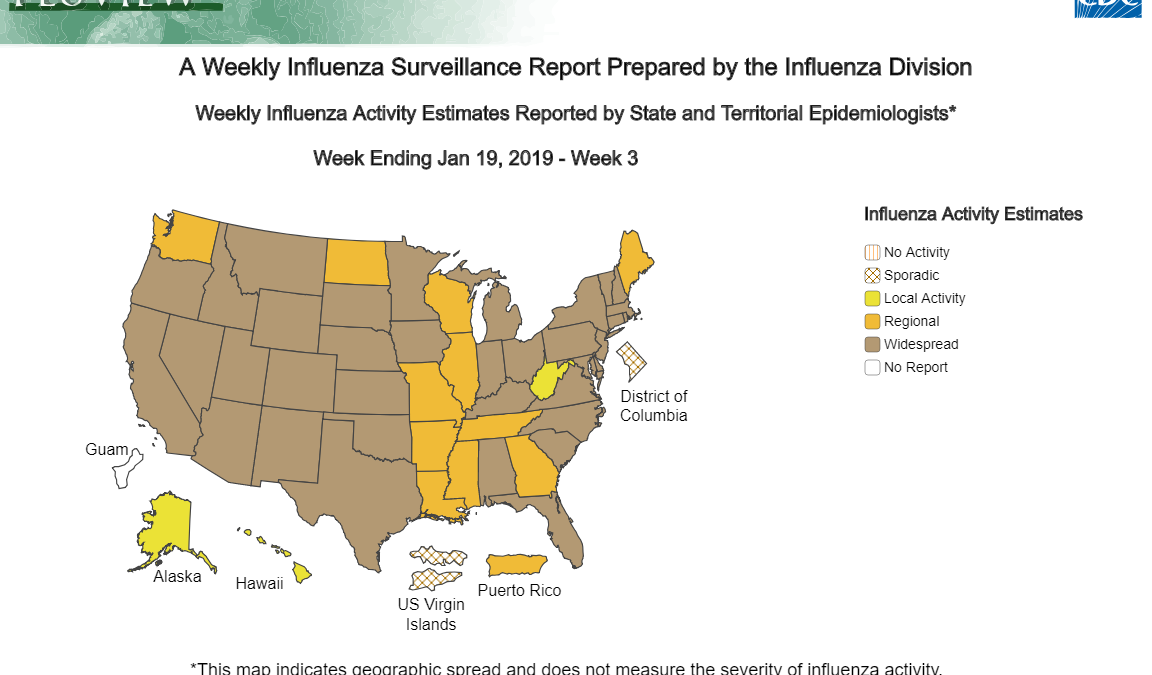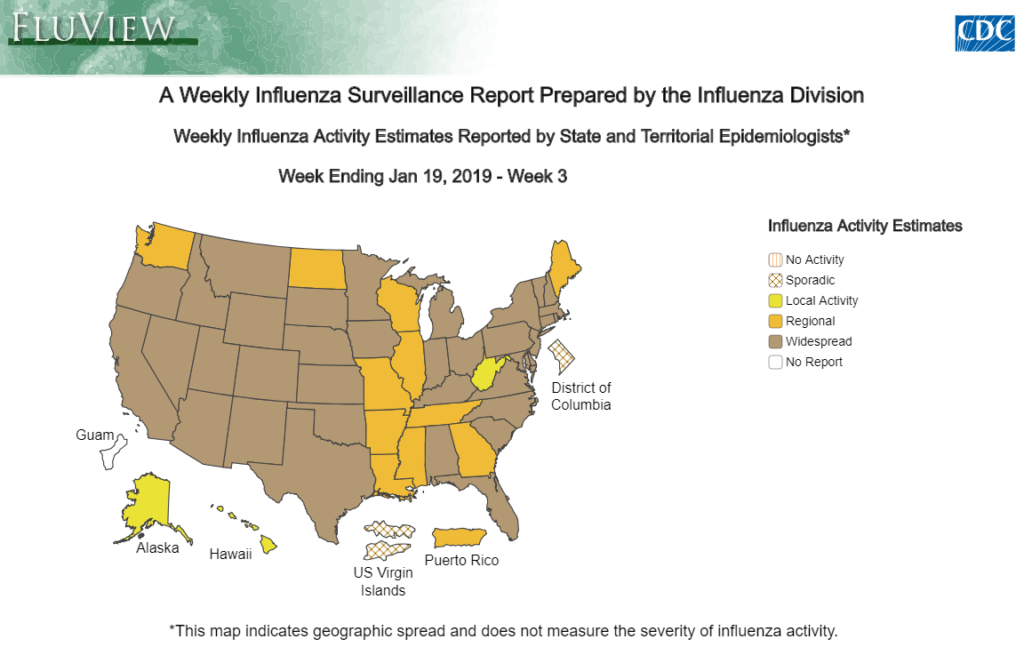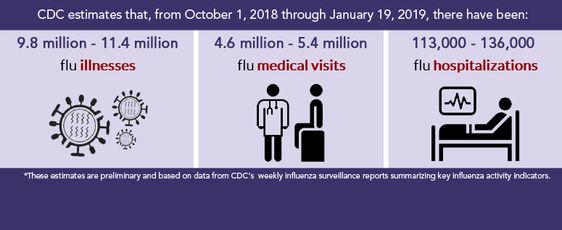

“CDC expects flu activity to remain elevated for a number of weeks. Below is a summary of the key flu indicators for the week ending January 19, 2019:
- Influenza-like Illness Surveillance: For the week ending January 19 (week 3), the proportion of people seeing their health care provider for influenza-like illness (ILI) increased from 3.1 percent to 3.3 percent, which is above the national baseline of 2.2 percent. All 10 regions reported a proportion of outpatient visits for ILI at or above their region-specific baseline level. For comparison purposes, over the past five flu seasons, the peak percent of visits due to ILI has ranged between 3.6 percent (2015-2016) and 7.5 percent (2017-2018). Additional ILINet data, including national, regional, and select state-level data for the current and previous seasons, can be found at http://gis.cdc.gov/grasp/fluview/fluportaldashboard.html.
- Influenza-like Illness State Activity Indicator Map: New York City and 18 states (Alabama, Colorado, Georgia, Indiana, Kansas, Kentucky, Louisiana, Maryland, Massachusetts, Nebraska, New Jersey, New Mexico, Oklahoma, Rhode Island, South Carolina, Texas, Vermont, and Virginia) experienced high ILI activity. 10 states (Alaska, Arizona, Arkansas, Mississippi, Missouri, Nevada, New Hampshire, New York, North Carolina, and Pennsylvania) experienced moderate ILI activity. The District of Columbia and 8 states (California, Connecticut, Illinois, Minnesota, Utah, West Virginia, Wisconsin, and Wyoming) experienced low ILI activity. 14 states (Delaware, Florida, Hawaii, Idaho, Iowa, Maine, Michigan, Montana, North Dakota, Ohio, Oregon, South Dakota, Tennessee, and Washington) experienced minimal ILI activity. Data was insufficient to calculate an ILI activity level for Puerto Rico. Additional data, including data for previous seasons, can be found at https://gis.cdc.gov/grasp/fluview/main.html.
- Geographic Spread of Influenza Viruses: Widespread influenza activity was reported by 36 states (Alabama, Arizona, California, Colorado, Connecticut, Delaware, Florida, Idaho, Indiana, Iowa, Kansas, Kentucky, Maryland, Massachusetts, Michigan, Minnesota, Montana, Nebraska, Nevada, New Hampshire, New Jersey, New Mexico, New York, North Carolina, Ohio, Oklahoma, Oregon, Pennsylvania, Rhode Island, South Carolina, South Dakota, Texas, Utah, Vermont, Virginia, and Wyoming). Regional influenza activity was reported by Puerto Rico and 11 states (Arkansas, Georgia, Illinois, Louisiana, Maine, Mississippi, Missouri, North Dakota, Tennessee, Washington, and Wisconsin. Local influenza activity was reported by three states (Alaska, Hawaii, and West Virginia). Sporadic influenza activity was reported by the District of Columbia and the U.S. Virgin Islands. Guam did not report. Geographic spread data reflect how many areas within a state or territory are seeing flu activity. Additional data are available at: https://gis.cdc.gov/grasp/fluview/FluView8.html.
- Flu-Associated Hospitalizations: Since October 1, 2018, 4,262 laboratory-confirmed influenza-associated hospitalizations have been reported through the Influenza Hospitalization Network (FluSurv-NET), a population-based surveillance network for laboratory-confirmed influenza-associated hospitalizations covering approximately 9% of the U.S. This translates to a cumulative overall rate of 14.8 hospitalizations per 100,000 people in the United States.
- The highest hospitalization rate is among adults aged 65 years and older (38.3 per 100,000) followed by children younger than 5 years (26.5 per 100,000), and adults aged 50-64 years (19.8 per 100,000). During most seasons, adults 65 years and older have the highest hospitalization rates followed by young children.
- For comparison purposes:
- The final, cumulative overall hospitalization rate for week 3 last season was 49.2 per 100,000.
- Over the past 5 seasons, cumulative end-of-season hospitalization rates have ranged from 31.4 per 100,000 (2015-2016) to 102.8 per 100,000 (2017-2018).
- Additional data, including hospitalization rates during previous influenza seasons, can be found at http://gis.cdc.gov/GRASP/Fluview/FluHospRates.html and http://gis.cdc.gov/grasp/fluview/FluHospChars.html.
- Mortality Surveillance: The proportion of deaths attributed to pneumonia and influenza (P&I) was 7.2 percent during the week ending January 12, 2019 (week 2). This percentage is above the epidemic threshold of 7.1% for week 2 in the National Center for Health Statistics (NCHS) Mortality Surveillance System. P&I data for week 1 backfilled to 7.0 percent, which is at the epidemic threshold for that week. P&I has now been at or above the epidemic threshold for 2 weeks so far this season.
- For comparison purposes, over the last five seasons, P&I has been at or above epidemic threshold for a range of four weeks (2015-2016) to 16 weeks (2017-2018).]
- Additional P&I mortality data for current and past seasons and by geography (national, HHS region, or state) are available at https://gis.cdc.gov/grasp/fluview/mortality.html
- Pediatric Deaths: Three influenza-associated pediatric deaths were reported to CDC during week 3 (the week ending January 19, 2019).
- Two deaths were associated with an influenza A(H1N1)pdm09 virus and occurred during weeks 51 and 2 (the weeks ending December 22, 2018 and January 12, 2019, respectively). One death was associated with an influenza A virus for which no subtyping was performed and occurred during week 1 (the week ending January 5, 2019).
- A total of 22 influenza-associated pediatric deaths have been reported for the 2018-2019 season.
- Additional information on influenza-associated pediatric deaths reported during past seasons, including basic demographics, underlying conditions, bacterial co-infections, and place of death is available on FluView Interactive at: https://gis.cdc.gov/GRASP/Fluview/PedFluDeath.html. More detailed information about pediatric deaths reported during the current season will be available later in the season.
Note: Delays in reporting may mean that data changes over time. The most up to date data for all weeks during the 2018-2019 season can be found on the current FluView and FluView Interactive.

